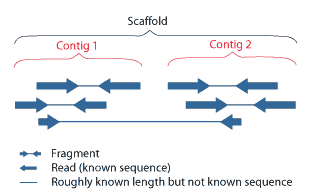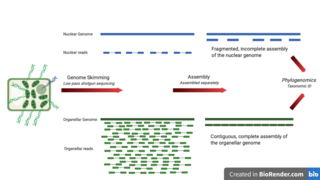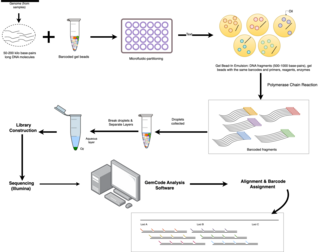Related Research Articles

A DNA sequencer is a scientific instrument used to automate the DNA sequencing process. Given a sample of DNA, a DNA sequencer is used to determine the order of the four bases: G (guanine), C (cytosine), A (adenine) and T (thymine). This is then reported as a text string, called a read. Some DNA sequencers can be also considered optical instruments as they analyze light signals originating from fluorochromes attached to nucleotides.

Genome projects are scientific endeavours that ultimately aim to determine the complete genome sequence of an organism and to annotate protein-coding genes and other important genome-encoded features. The genome sequence of an organism includes the collective DNA sequences of each chromosome in the organism. For a bacterium containing a single chromosome, a genome project will aim to map the sequence of that chromosome. For the human species, whose genome includes 22 pairs of autosomes and 2 sex chromosomes, a complete genome sequence will involve 46 separate chromosome sequences.
In bioinformatics, sequence assembly refers to aligning and merging fragments from a longer DNA sequence in order to reconstruct the original sequence. This is needed as DNA sequencing technology might not be able to 'read' whole genomes in one go, but rather reads small pieces of between 20 and 30,000 bases, depending on the technology used. Typically, the short fragments (reads) result from shotgun sequencing genomic DNA, or gene transcript (ESTs).
Velvet is an algorithm package that has been designed to deal with de novo genome assembly and short read sequencing alignments. This is achieved through the manipulation of de Bruijn graphs for genomic sequence assembly via the removal of errors and the simplification of repeated regions. Velvet has also been implemented in commercial packages, such as Sequencher, Geneious, MacVector and BioNumerics.

RNA-Seq is a sequencing technique that uses next-generation sequencing (NGS) to reveal the presence and quantity of RNA in a biological sample, representing an aggregated snapshot of the cells' dynamic pool of RNAs, also known as transcriptome.
Complete Genomics is a life sciences company that has developed and commercialized a DNA sequencing platform for human genome sequencing and analysis. This solution combines the company's proprietary human genome sequencing technology with its informatics and data management software to provide finished variant reports and assemblies at Complete Genomics’ commercial genome center in Mountain View, California.
The 1000 Plant Transcriptomes Initiative (1KP) was an international research effort to establish the most detailed catalogue of genetic variation in plants. It was announced in 2008 and headed by Gane Ka-Shu Wong and Michael Deyholos of the University of Alberta. The project successfully sequenced the transcriptomes of 1000 different plant species by 2014; its final capstone products were published in 2019.
De novo transcriptome assembly is the de novo sequence assembly method of creating a transcriptome without the aid of a reference genome.
In DNA sequencing, a read is an inferred sequence of base pairs corresponding to all or part of a single DNA fragment. A typical sequencing experiment involves fragmentation of the genome into millions of molecules, which are size-selected and ligated to adapters. The set of fragments is referred to as a sequencing library, which is sequenced to produce a set of reads.

Scaffolding is a technique used in bioinformatics. It is defined as follows:
Link together a non-contiguous series of genomic sequences into a scaffold, consisting of sequences separated by gaps of known length. The sequences that are linked are typically contiguous sequences corresponding to read overlaps.
SPAdes is a genome assembly algorithm which was designed for single cell and multi-cells bacterial data sets. Therefore, it might not be suitable for large genomes projects.

Wang Jun is a Chinese scientist, founder and CEO of iCarbonX, and former CEO of the Beijing Genomics Institute.
In genetics, coverage is one of several measures of the depth or completeness of DNA sequencing, and is more specifically expressed in any of the following terms:
De novo sequence assemblers are a type of program that assembles short nucleotide sequences into longer ones without the use of a reference genome. These are most commonly used in bioinformatic studies to assemble genomes or transcriptomes. Two common types of de novo assemblers are greedy algorithm assemblers and De Bruijn graph assemblers.
Transcriptomics technologies are the techniques used to study an organism's transcriptome, the sum of all of its RNA transcripts. The information content of an organism is recorded in the DNA of its genome and expressed through transcription. Here, mRNA serves as a transient intermediary molecule in the information network, whilst non-coding RNAs perform additional diverse functions. A transcriptome captures a snapshot in time of the total transcripts present in a cell. Transcriptomics technologies provide a broad account of which cellular processes are active and which are dormant. A major challenge in molecular biology is to understand how a single genome gives rise to a variety of cells. Another is how gene expression is regulated.
Bloom filters are space-efficient probabilistic data structures used to test whether an element is a part of a set. Bloom filters require much less space than other data structures for representing sets, however the downside of Bloom filters is that there is a false positive rate when querying the data structure. Since multiple elements may have the same hash values for a number of hash functions, then there is a probability that querying for a non-existent element may return a positive if another element with the same hash values has been added to the Bloom filter. Assuming that the hash function has equal probability of selecting any index of the Bloom filter, the false positive rate of querying a Bloom filter is a function of the number of bits, number of hash functions and number of elements of the Bloom filter. This allows the user to manage the risk of a getting a false positive by compromising on the space benefits of the Bloom filter.

Genome skimming is a sequencing approach that uses low-pass, shallow sequencing of a genome, to generate fragments of DNA, known as genome skims. These genome skims contain information about the high-copy fraction of the genome. The high-copy fraction of the genome consists of the ribosomal DNA, plastid genome (plastome), mitochondrial genome (mitogenome), and nuclear repeats such as microsatellites and transposable elements. It employs high-throughput, next generation sequencing technology to generate these skims. Although these skims are merely 'the tip of the genomic iceberg', phylogenomic analysis of them can still provide insights on evolutionary history and biodiversity at a lower cost and larger scale than traditional methods. Due to the small amount of DNA required for genome skimming, its methodology can be applied in other fields other than genomics. Tasks like this include determining the traceability of products in the food industry, enforcing international regulations regarding biodiversity and biological resources, and forensics.

Linked-read sequencing, a type of DNA sequencing technology, uses specialized technique that tags DNA molecules with unique barcodes before fragmenting them. Unlike traditional sequencing technology, where DNA is broken into small fragments and then sequenced individually, resulting in short read lengths that has difficulties in accurately reconstructing the original DNA sequence, the unique barcodes of linked-read sequencing allows scientists to link together DNA fragments that come from the same DNA molecule. A pivotal benefit of this technology lies in the small quantities of DNA required for large genome information output, effectively combining the advantages of long-read and short-read technologies.
References
- 1 2 Li, R.; Yu, C.; Li, Y.; Lam, T.-W.; Yiu, S.-M.; Kristiansen, K.; Wang, J. (2009). "SOAP2: an improved ultrafast tool for short read alignment". Bioinformatics. 25 (15): 1966–1967. doi:10.1093/bioinformatics/btp336. ISSN 1367-4803. PMID 19497933.
- ↑ Li, R.; Zhu, H.; Ruan, J.; Qian, W.; Fang, X.; Shi, Z.; Li, Y.; Li, S.; Shan, G.; Kristiansen, K.; Li, S.; Yang, H.; Wang, J.; Wang, J. (2009). "De novo assembly of human genomes with massively parallel short read sequencing". Genome Research. 20 (2): 265–272. doi:10.1101/gr.097261.109. ISSN 1088-9051. PMC 2813482 . PMID 20019144.
- ↑ Li, Ruiqiang; Fan, Wei; Tian, Geng; Zhu, Hongmei; He, Lin; Cai, Jing; Huang, Quanfei; Cai, Qingle; Li, Bo; Bai, Yinqi; Zhang, Zhihe; Zhang, Yaping; Wang, Wen; Li, Jun; Wei, Fuwen; Li, Heng; Jian, Min; Li, Jianwen; Zhang, Zhaolei; Nielsen, Rasmus; Li, Dawei; Gu, Wanjun; Yang, Zhentao; Xuan, Zhaoling; Ryder, Oliver A.; Leung, Frederick Chi-Ching; Zhou, Yan; Cao, Jianjun; Sun, Xiao; et al. (2009). "The sequence and de novo assembly of the giant panda genome". Nature. 463 (7279): 311–317. Bibcode:2010Natur.463..311L. doi:10.1038/nature08696. ISSN 0028-0836. PMC 3951497 . PMID 20010809.
- ↑ Luo, Ruibang; Liu, Binghang; Xie, Yinlong; Li, Zhenyu; Huang, Weihua; Yuan, Jianying; He, Guangzhu; Chen, Yanxiang; Pan, Qi; Liu, Yunjie; Tang, Jingbo (2012-12-01). "SOAPdenovo2: an empirically improved memory-efficient short-read de novo assembler". GigaScience. 1 (1): 18. doi: 10.1186/2047-217X-1-18 . PMC 3626529 . PMID 23587118.
- ↑ Xie, Yinlong; Wu, Gengxiong; Tang, Jingbo; Luo, Ruibang; Patterson, Jordan; Liu, Shanlin; Huang, Weihua; He, Guangzhu; Gu, Shengchang; Li, Shengkang; Zhou, Xin (2014-06-15). "SOAPdenovo-Trans: de novo transcriptome assembly with short RNA-Seq reads". Bioinformatics. 30 (12): 1660–1666. arXiv: 1305.6760 . doi: 10.1093/bioinformatics/btu077 . ISSN 1367-4803. PMID 24532719.
- ↑ Li, Shengting; Li, Ruiqiang; Li, Heng; Lu, Jianliang; Li, Yingrui; Bolund, Lars; Schierup, Mikkel H.; Wang, Jun (2013-01-01). "SOAPindel: Efficient identification of indels from short paired reads". Genome Research. 23 (1): 195–200. doi: 10.1101/gr.132480.111 . ISSN 1088-9051. PMC 3530679 . PMID 22972939.
- ↑ Li, Yingrui; Zheng, Hancheng; Luo, Ruibang; Wu, Honglong; Zhu, Hongmei; Li, Ruiqiang; Cao, Hongzhi; Wu, Boxin; Huang, Shujia; Shao, Haojing; Ma, Hanzhou (August 2011). "Structural variation in two human genomes mapped at single-nucleotide resolution by whole genome de novo assembly". Nature Biotechnology. 29 (8): 723–730. doi: 10.1038/nbt.1904 . ISSN 1546-1696. PMID 21785424.
- ↑ Chen, Yuxin; Chen, Yongsheng; Shi, Chunmei; Huang, Zhibo; Zhang, Yong; Li, Shengkang; Li, Yan; Ye, Jia; Yu, Chang; Li, Zhuo; Zhang, Xiuqing (2018-01-01). "SOAPnuke: a MapReduce acceleration-supported software for integrated quality control and preprocessing of high-throughput sequencing data". GigaScience. 7 (1): 1–6. doi:10.1093/gigascience/gix120. PMC 5788068 . PMID 29220494.
- ↑ Li, R.; Li, Y.; Kristiansen, K.; Wang, J. (2008). "SOAP: short oligonucleotide alignment program". Bioinformatics. 24 (5): 713–714. doi: 10.1093/bioinformatics/btn025 . ISSN 1367-4803. PMID 18227114.
- ↑ Liu, C.-M.; Wong, T.; Wu, E.; Luo, R.; Yiu, S.-M.; Li, Y.; Wang, B.; Yu, C.; Chu, X.; Zhao, K.; Li, R.; Lam, T.-W. (2012). "SOAP3: ultra-fast GPU-based parallel alignment tool for short reads". Bioinformatics. 28 (6): 878–879. doi: 10.1093/bioinformatics/bts061 . ISSN 1367-4803. PMID 22285832.